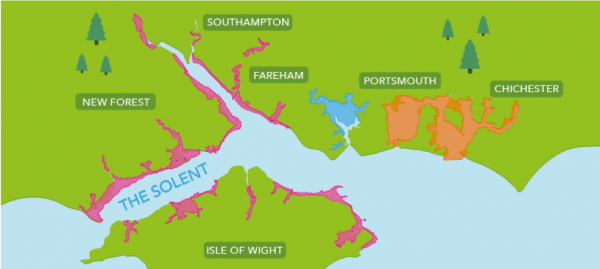Nutrient neutrality… Dream or nightmare?
Geoenvironmental • Industry matters
 Flushing the loo, pulling the plug on the bathwater and washing your hands are all normal, necessary actions of daily life. For most of us, once this water stops circling the plug hole and disappears down the U-bend, that’s it. Water on its way, never to be thought of again. However, for developers in the Solent region, the journey continues all the way to the coast. Ground & Water Engineer, Aubyn Shortland, asks: Nutrient Neutrality: Environmental Dream or Developer Nightmare?
Flushing the loo, pulling the plug on the bathwater and washing your hands are all normal, necessary actions of daily life. For most of us, once this water stops circling the plug hole and disappears down the U-bend, that’s it. Water on its way, never to be thought of again. However, for developers in the Solent region, the journey continues all the way to the coast. Ground & Water Engineer, Aubyn Shortland, asks: Nutrient Neutrality: Environmental Dream or Developer Nightmare?
Within the Solent catchment, the Isle of Wight provides a shelter to the discharging waters from the south coast, which in turn creates a complex tidal system. Over time, these processes have created some of the most unique and important ecosystems in the United Kingdom. From wading bird species picking out worms from mudflats, to seagrass meadows sheltering juvenile fish… The Solent has it all.
 (www.birdawaresolent.com)
(www.birdawaresolent.com)
But how does this relate to your poop? It is no secret that human activities are injecting higher levels of nitrates and phosphorous into watercourses, thus speeding up the natural process of eutrophication. Eutrophication is characterised by excessive plant and algal growth that due to the increased availability of nutrients, grow into vast clouds of thick, dank, foul smelling blooms. These blooms reduce sunlight penetration and cause the depletion of dissolved oxygen, which impacts all aquatic organisms, unlucky enough to find themselves in the surrounding waters. Remember the stinky swimming pool at the Rio 2016 Olympic Games? That was a clear example of how easily a chemical imbalance can spark an algae takeover!
 So, what is the solution? In June 2019, Natural England issued guidance to all planning authorities within the Solent region, specifying that specific planning conditions should be placed on all new developments including residential dwellings, overnight accommodation, tourist facilities and student accommodation. To curb the anthropogenic injection of nitrates and phosphorous into watercourses, all new developments should outline how they plan to achieve “Nutrient Neutrality”. Nutrient neutrality is a means of ensuring that developments do not add to the existing nutrient burdens and provides certainty that the whole of the scheme is deliverable, in line with the requirements of the Conservation of Habitats and Species Regulations 2017.
So, what is the solution? In June 2019, Natural England issued guidance to all planning authorities within the Solent region, specifying that specific planning conditions should be placed on all new developments including residential dwellings, overnight accommodation, tourist facilities and student accommodation. To curb the anthropogenic injection of nitrates and phosphorous into watercourses, all new developments should outline how they plan to achieve “Nutrient Neutrality”. Nutrient neutrality is a means of ensuring that developments do not add to the existing nutrient burdens and provides certainty that the whole of the scheme is deliverable, in line with the requirements of the Conservation of Habitats and Species Regulations 2017.
New developments are tasked with achieving neutrality by first understanding the expected increase of available nutrients the development will cause. For example, a private residential development measuring approximately 2000sq.m with wastewater sent via an unknown water treatment works, is expected to create a net nitrogen increase of 6.30kg/yr. It is then up to the developer to account for this increase and demonstrate how it is to be mitigated. Possible mitigation measures include woodland planting on agricultural land, or the creation of wetlands to receive nitrogen-rich waters, which processes such as sedimentation help to extract and trap nitrates.
Putting this guidance into practise however, can be a sticky and often time-consuming process, for both the developer and the environmental consultancy tasked with achieving the all-important nutrient neutrality status. The strict guidance set by Natural England and its explicit advice to local planning authorities to take a precautionary approach when addressing applications, is causing an ever-growing backlog of planning applications. Since its inception in 2019, the guidance has been updated numerous times, which has caused further delays to applications as they are bounced back and ordered to be updated. Being based in Alton, Hampshire, Ground & Water has experienced, first-hand, the frustration this process has caused our clients.
If you are reading this and about to embark on a new development within the Solent region, it is important to take on board the following points:
Firstly, understand your drainage network. The guidance heavily penalises developments using non-mains drainage, such as package treatment plans. If this applies to your development, get ready to produce a bespoke approach (and a lot of emails).
Secondly, ensure the development includes adequate room for mitigation measures. The precautionary approach adopted by Natural England requires a 20% buffer to be applied before the final net nitrogen load is calculated. So, no matter how skilled the environmental consultant is, the house always wins. Developments can only be considered acceptable, if they are able to support the mitigation required. Planning authorities will need to know exactly where the mitigation site location is and information including size, delivery, enforceability and proof of securing the adopted measures for the duration of the development’s effects.
Lastly, plan ahead. Like most planning applications, nutrient neutrality conditions take time and plenty of patience. Having a clear and informed approach sorted before starting the process, will aid in helping reduce frustrations later down the line. Ninety-nine times out of a hundred, mitigation measures will be required; so having them accounted and budgeted for, from the start, will help mitigate any unplanned surprises further down the line.
